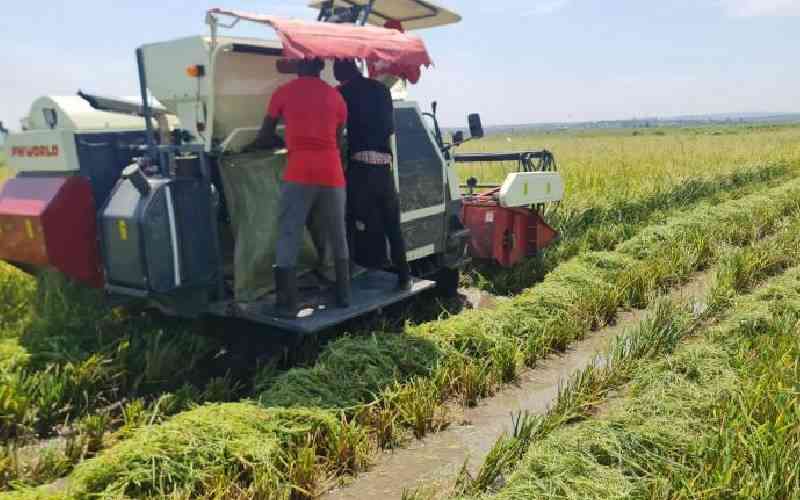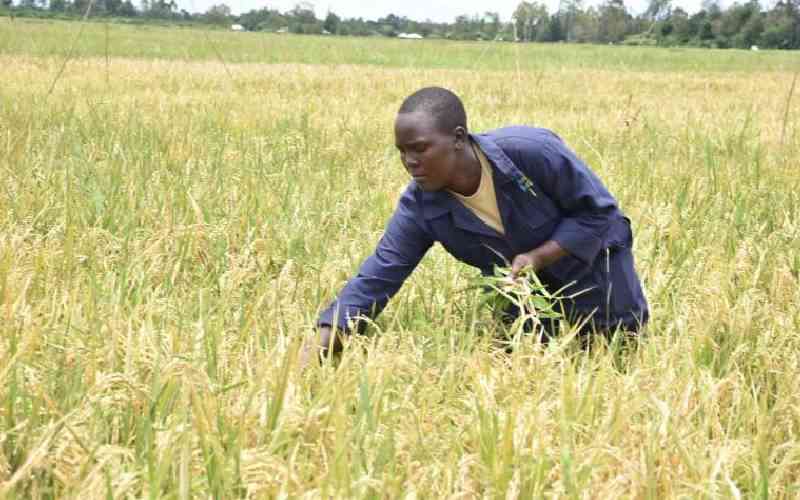Under the scorching sun, farmer Dennis Onyango was replanting his rice fields yet again in Ahero, a town in southwest Kenya, after his entire crop of seedlings had been wiped out by floods - for the third time this year.
The 35-year-old father of five said the first flood came when heavy rains hit Kisumu County in early April. The flooding flattened and waterlogged his young plants, forcing him to buy new seedlings and start again.
The same thing happened at the end of April, and then again three weeks ago. “Now I have run out of money to buy seedlings from other farmers,” he lamented, removing dead seedlings from between his new rice plants.
“I have been a rice farmer for the past 15 years, but what I have witnessed in the past few weeks has been catastrophic. I have never seen this before,” he added.
The inundation of rice fields across Kenya over the past two months could worsen food insecurity in a country already struggling to feed a fast-urbanising population, said Joel Tanui, western Kenya manager at the National Irrigation Board (NIB).
Climate scientists say sudden, intense floods are becoming more common due to extreme weather worsened by global warming.
Kenya’s recent floods have ruined harvests in several rice production hubs - including Kisumu, Homa Bay and Busia counties - which Tanui said together supply up to 40% of all rice grown in the country.
Although rice is a thirsty crop that needs a lot of water, the force of the flooding can be so strong that it crushes rice stalks and strips the grains from the plants, he explained.
Any plants still standing drown after spending hours or even days submerged in water.
Like many of the 2,000 farmers living and working in the area covered by the Ahero Irrigation Scheme, Onyango relies on the income he gets from selling rice to feed his family and send his children to school.
In a year with two good yields, he makes about 120,000 Kenyan shillings (about $1,120).
“But this year, things will be tough as I have already spent all I had buying seedlings to replant. And yet I have no idea what will happen tomorrow if it floods again,” he said.
URBAN STAPLE
Since April, about 7,500 acres (3,035 hectares) of rice have been destroyed by floods, according to data from the NIB, which sits under the agriculture ministry and manages the farming projects that grow most of Kenya’s rice, including in Ahero.
According to a 2014 report from the United Nations’ Food and Agriculture Organization, rice is the “third most important” food staple in Kenya after maize and wheat.
Stay informed. Subscribe to our newsletter
Most rice is consumed by city residents, with rural Kenyans relying on it to make an income but preferring to eat maize and wheat, the report noted.
And rice is only getting more popular, with national consumption increasing at a rate of 12 per cent, compared to 1 per cent for maize and 4 per cent for wheat, it said.
With more than a quarter of Kenya’s population now living in cities, according to the World Bank, this year’s floods in major rice-growing areas threaten to put pressure on food supplies.
“As many people in the country continue to move to urban areas, most of them largely depend on rice as a staple food, unlike those in rural areas who hardly eat rice,” said the NIB’s Tanui.
The U.S. Agency for International Development reported in April that about 1.3 million Kenyans - almost 3% of the population - were facing crisis levels of food insecurity, or worse.
And a mid-May report by the European Commission humanitarian aid department said heavy, prolonged rains had directly affected 1.26 million people across the Horn of Africa since March.
The extreme weather is adding to the woes of farmers already dealing with locust invasions, it said, warning the combination of those things would increase the number of people in need.
“We are experiencing extreme weather events that are not only affecting food but also all other ways of life, because people have been displaced and farmlands destroyed,” said Amos Wemanya, a campaigner with Greenpeace Africa.
“That means farmers are not able to produce enough food for this country,” he told the Thomson Reuters Foundation.
‘EVERYTHING DESTROYED’
Wemanya suggested rice farmers could turn to agroforestry - the practice of planting trees among crops - to help protect their plants, as the trees can break up and slow down flood waters while stabilising the soil.
In the short-term, Tanui said, the government cannot rely on imports to make up for rice lost in the floods, especially with the novel coronavirus pandemic slowing or completely stopping travel and farming activities around the world.
Of the 600,000 metric tonnes of rice Kenyans consume each year, more than three-quarters is imported, mainly from Pakistan and Vietnam.
“Importing more rice (right now) would not only take almost the same amount of time as producing more, but would also be a challenge since many governments have stopped exports due to COVID-19,” Tanui said.
Farmers in Ahero say they would like the government to help them pay for seeds and equipment, and waive the loans they got from the Agricultural Finance Corporation, a government agency.
Next to Onyango’s plantation in Ahero, William Otieno was also counting his losses after his rice field was hit by floods.
His rice was still in the seedbed, waiting to be planted in the main field, when it was submerged - some of the seedlings were washed away, the rest died after being soaked for too long.
"We had taken out loans to be able to plant this season and now that everything has been destroyed, we have used all our savings to replant," Otieno said, showing some of the crushed seedlings. "The government should just help us."
 The Standard Group Plc is a
multi-media organization with investments in media platforms spanning newspaper
print operations, television, radio broadcasting, digital and online services. The
Standard Group is recognized as a leading multi-media house in Kenya with a key
influence in matters of national and international interest.
The Standard Group Plc is a
multi-media organization with investments in media platforms spanning newspaper
print operations, television, radio broadcasting, digital and online services. The
Standard Group is recognized as a leading multi-media house in Kenya with a key
influence in matters of national and international interest.
 The Standard Group Plc is a
multi-media organization with investments in media platforms spanning newspaper
print operations, television, radio broadcasting, digital and online services. The
Standard Group is recognized as a leading multi-media house in Kenya with a key
influence in matters of national and international interest.
The Standard Group Plc is a
multi-media organization with investments in media platforms spanning newspaper
print operations, television, radio broadcasting, digital and online services. The
Standard Group is recognized as a leading multi-media house in Kenya with a key
influence in matters of national and international interest.








